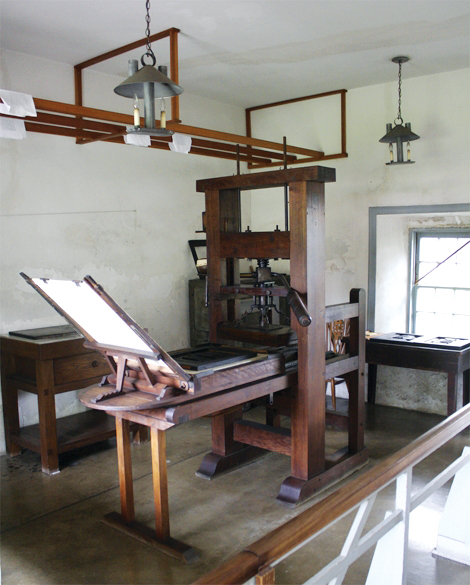The printing press made an indelible impact on Hawaiian history. Beyond first recording the written Hawaiian language, propelling the education of the populace, and capturing the growing collection of Hawaiian hymns, it spurred the rise of Hawaiian-language newspapers, which today provide an extensive historical record.
Lahainaluna School and the Second Press
Established in 1831 under the leadership of Rev. Lorrin Andrews10, the “mission seminary” at Lahainaluna, Maui, was for “young men of piety and promising talents.” After a second printing press had been delivered to Honolulu with the third company in 1828, the original press, brought on the Thaddeus, was moved to Lahainaluna.
In its earliest days, students at Lahainaluna were known for their scholarship, skills at drawing maps, creating engravings, as well as printing newspapers, portions of the Baibala, laws and the first history of Hawai‘i written in Hawaiian.
Nūpepa: Capturing a Changing Hawai‘i
- About 70 different Hawaiian-language newspapers were published from 1834 – 1948, creating a vast trove of information. It stands as part of “the largest native-language historical and literature archives in the Pacific, and perhaps all of native North America.”11
- Ka Lama Hawaii, the first Hawaiian-language newspaper, was published in February 1834, by students at Lahainaluna School. Andrews sought to introduce students to worldly affairs and encourage free expression. Along with a delightful series on four-footed animals, Ka Lama ran essays that extolled “the ‘superiority’ of American culture, the Christian religion and the Protestant work ethic.”12
- Ke Kumu Hawaii, also published in 1834, was a semi-monthly publication of the Sandwich Islands Mission. This popular paper, with a run of 1,500 copies, encouraged Hawaiians to embrace piety and industriousness. A series of pro-reform articles published in Ke Kumu during the 1830s, written by Hawaiian graduates of Lahainaluna, helped persuade Kauikeaouli (Kamehameha III) to undertake major governmental reform.
- The Polynesian, the Hawaiian government’s English-language publication, debuted in 1840. Land ownership was a pressing concern for editor J.J. Jarves, who believed that private land rights were needed to bring capital investment to Hawai‘i. Private property rights, he and others stressed, were a hallmark of “civilized” nations.
- Ka Nupepa Kuokoa, an influential independent newspaper, edited by Henry M. Whitney,13 published “genealogies, … bird catching and fishing practices, instructions on canoe building, summaries of medical practices, … and how to speak the Hawaiian language correctly.”14 Kuokoa also published essays by royal adviser, John Papa Ī‘ī and the writings of historian Samuel M. Kamakau, which were later compiled into the landmark book, Ruling Chiefs of Hawai‘i.
— Helen Geracimos Chapin, Shaping History: The Role of Newspapers in Hawai‘i, p. 32
Hawaiians struggled to find their opinions reflected in the major publications, which were edited by foreign missionaries, businessmen or government officials. However, a petition addressed to the king and chiefs was printed in Hawaiian by Ka Elele Hawaii (semimonthly newspaper, 1845 – 1866) in July 1845, urging the king to dismiss his foreign advisers and reject private-land ownership. The acquisition of land by foreigners, the signatories argued, “will soon lead to our being reduced to servitude.” In 1861, Ka Hoku o Ka Pakipika, a newspaper edited and written by Hawaiians,15 appeared, but ran only until 1863.
10 The Rev. Lorrin Andrews was a member of the Third Company that arrived in Hawai’i in 1828.
11 Arista, Noelani, The Kingdom and the Republic: Sovereign Hawai‘i and the Early United States, p. 6.
12 Chapin, Helen Geracimos, Shaping History: The Role of Newspapers in Hawai‘i, University of Hawai‘i Press, Honolulu, 1996, p. 16.
13 Henry M. Whitney was the son of Samuel and Mercy Whitney of the Pioneer Company. He was born on Kaua‘i, educated in New England, and worked in publishing in New York before returning to Hawai‘i. While Whitney hired talented Hawaiian editors to work on Ka Nupepa Kuokoa, he stated that one of newspaper’s goals was “the publication of all things educational for the benefit of Hawaiians so that their way of life will resemble that of the haole.”
14 Chapin, Ibid., p. 57.
15 David Kalākaua, who took the throne in 1874, was among the editors of this newspaper, earning him the nickname, the “Editor King.”



